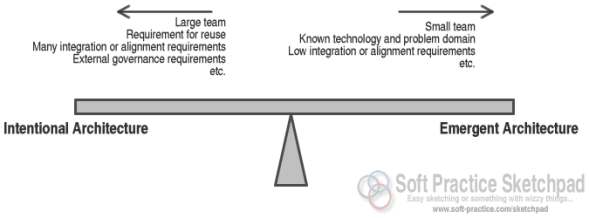Intentional vs. Emergent Architecture
I’ve been thinking about architecture a lot recently but one thing that I often discuss but have never blogged about for some odd reason is intentional vs. emergent software architecture. Some old fashioned software methods such as waterfall led people into doing a lot of up front architecture work, they analysed and designed away for ages producing huge reams of UML and documentation that no one could ever squeeze into their heads if they had the patience to read it. This is an example of an intentional architecture – the architecture was intended, planned and deliberate.
Lots of folks hated that way of doing things as it meant people were writing docs and drawing diagrams instead of making working software, not to mention an all to frequent tendency to over-engineer architecture past the point of usefulness. This led to some people saying that we’re better off not trying to do any architecture and just letting it emerge from the work we do developing small little customer focused requirements (like user stories or similar). Ok, so there’d be some rework along the way as we encounter a deeper understanding of the system and refactor our emergent architecture but it’d still be better than the old way of doing large upfront architecture.
So, there seem to be two opposed viewpoints: intentional architecture is best, emergent architecture is best.
For me, neither is true. I’ve seen some really terrible examples of badly over-engineered architectures that crippled a project and projects that never got past their over-reaching architectural analysis. Equally I’ve seen products with emergent architecture that had to be entirely re-architected as time went pay because their emergent architecture was so wrong it was comical (imagine a software management tool that only supports a single project, and that concept being deeply embedded in the architecture).
There’s a scale with intentional architecture on one side and emergent architecture on the other.
 Various factors might push us one way or another… The second I listed on the right is interesting as if you’ve got a well known technology and problem domain you can get away with emergent architecture, but similarly if you have a totally unknown technology and problem domain it can be very effective to evolve towards a solution and architecture rather than crystal ball gaze by creating a (probably wrong) intentional architecture.
Various factors might push us one way or another… The second I listed on the right is interesting as if you’ve got a well known technology and problem domain you can get away with emergent architecture, but similarly if you have a totally unknown technology and problem domain it can be very effective to evolve towards a solution and architecture rather than crystal ball gaze by creating a (probably wrong) intentional architecture.
Which rather sums up the point I’m trying to make. The purpose of architecture is to shape the solution and address technical risks. Solving the big problems, creating common ways of doing something (lightweight architectural mechanisms) are all good architectural goals but only if we’re sure of the solution. If we’re not we’re better off evolving an emergent architecture, at least initially.
I think that the extremes at either end of the scale, as with most extremes, are a bad idea at best and impossible at worst. If you gather a group of people together and tell them to create a web app given a backlog but they’re not allowed to think or communicate about the architecture up front then you’ll find they all start dividing the problem in different ways and writing in different languages for different server and client frameworks. Hardly a good idea. Of course on the other end of the scale, believing that we can foresee all of the technical issues, all of the technology and requirements changes that might happen is as likely as a 12 month project plan Gantt chart being correct after a few levels of cumulative error margin have been combined.
For more on architecture see:
Great post, “emergent architecture” has been taboo couple of words in most projects I’ve worked in. I think developing based on just enough principles to stop teams heading for cliffs in their development, and encouraging reviews and aggressive refactoring would be my preferred approach so not all the thinking needs to be done upfront (typically by 1 person in the team).
February 4, 2013 at 10:45 pm
Yep, the power of code reviews tends to outstrip most design effort and encourages team ownership. I’d love to see more code reviews going on 🙂
February 4, 2013 at 10:55 pm
Hey, nice post. I believe that emergent architecture works in little increments on the low-level, but you need to do intentional architecture to solve larger problems. I wrote about the same topic here: http://www.making-software.com/2013/08/07/every-app-has-an-architecture/
August 7, 2013 at 4:15 pm